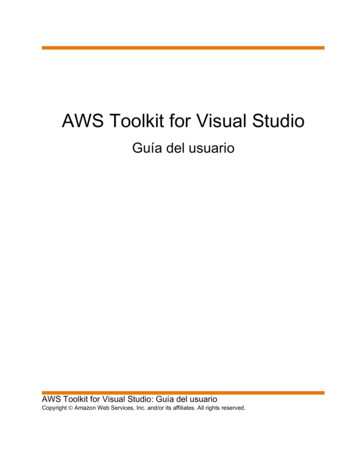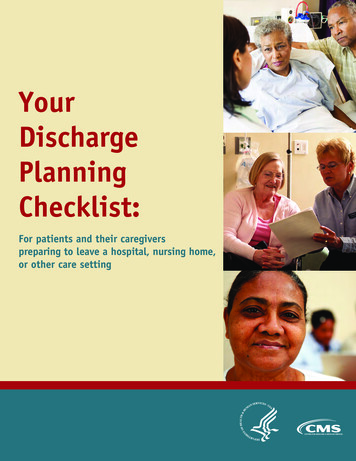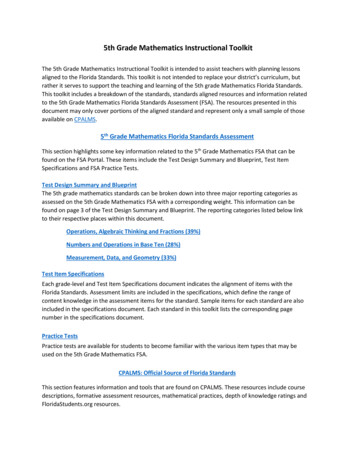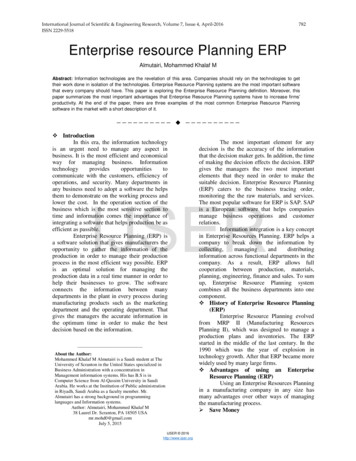
Transcription
Community PlanningToolkitCommunityEngagement
Community Planning Toolkit - Community EngagementDeveloped by Community Places throughthe support of the BIG Lottery Fund2014www.communityplanningtoolkit.org
Community Planning Toolkit - Community EngagementContents1. Introduction 032. Planning and DesigningCommunity Engagement03Thinking through the following questions andissues will help in the planning and design ofcommunity engagement. What level of participation is it hoped will beachieved?3. Quality Standards for Community 07Engagement How to identify the stakeholders? Communications.4. Online Tool to Guide Engagement 08Activity - VOiCE Stage of the engagement process. Resources. Are there any limitations? Timely feedback and next steps. Tools to help choose a method. Methods.5. Tools to Help to Choose aMethod(s)086. Methods and Techniques097. Resources 241. IntroductionThis section of the toolkit provides guidanceon the issues to consider when planning anddesigning community engagement. It focuses onquality and effectiveness, process planning anddesigning engagement tailored to the particularissue, level of participation to be achieved,timeframe and range of stakeholders affected.2. Planning and Designing CommunityEngagementCommunity engagement works best whereit is an ongoing cumulative process enablingrelationships and trust to build and strengthenover time. Individual engagement events shouldbe planned and designed with this in mindand aim to contribute to the overall aims of theengagement process. Community or voluntarygroups may want to participate at a range oflevels – from providing advice to co-designingthe process and from undertaking some aspectsof the engagement to delivering projects to meetsome of the outcomes.What is the purpose and scope of theengagement process?From the outset be clear about the scopeand purpose of the engagement process. Forexample, is the process designed to: Identify or prioritise what the needs andpriorities for Community Planning should be? Develop a consensus on a proposal or plan? Inform the decision-making or servicedelivery of a community, council ordepartment? Develop new or collaborative ways ofimplementing elements of the CommunityPlan? Review progress on the Community Plan?Agreeing a clear purpose will help identifyengagement objectives, anticipated outcomesand help to determine the scope and depthof the engagement. This can range fromconsultation to involvement in decision makingthrough to community and voluntary groupsdelivering projects and services. Providinginformation on proposals, plans or servicesis part of any communication plan to supportengagement but is not in itself communityengagement. Often communities will need3
Community Planning Toolkit - Community Engagementsupport to help them engage meaningfully. The Community and Voluntary Sectors (CVS) are skilledin providing this support – but may need access to resources to do so.What level of participation are you hoping to achieve?Community stakeholders can participate in a variety of ways, and to different levels of influence, inidentifying needs, generating solutions, planning new initiatives and service delivery as illustrated inthe diagram below:Users and Beneficiariesof the activities and funds of the partnership.This is the most basic level of engagement.Advisersto the partnership through their involvement inconsultations, working parties and evaluationswhich seek their guidance and feedback.Contributors to Managementthrough membership of forums and steeringgroups that work alongside staff supervisingprogress on partnership activities.In Dundee, each of the 8 local communityplans, which are developed by local communityplanning partnerships, sets out a CommunityEngagement Action Plan. The Action Plan aimsto raise the levels and quality of participation atthe local level and encourage local communitiesto identify and address issues and concernsthrough the community planning processR2Identifying stakeholdersEvery community will be made up of a range ofstakeholder interests. These might include:Decision Makers primarily through their membership of thepartnership board, but also when periodicconsultations are taking place about strategicchoices and other major decisions.Deliverersof projects and programmes on behalf of thepartnership and as local successor bodies thatare being developed to take over projects andprogrammes from the partnership.Diagram 1: Five Roles for the Community R1Community Participation p.13Sunderland Community Development Plan(2008, p.7) identify another way of thinkingabout different levels of involvement:Being InformedBeing AskedCommenting on DecisionsDeveloping SolutionsDelivering ntPartnershipLocal Residents or Area Based GroupsCommunities of InterestFaith Based GroupsRacial, Ethnic and Cultural GroupsLocal Community and Voluntary GroupsWeb Based or Virtual GroupsIt will be essential to utilise a range ofmechanisms and avenues to facilitate the widestpossible participation from these interests. Localcommunity development networks and supportorganisations should be involved in identifyingcommunity stakeholders, their particular interestsand needs and how best to engage with them.Issues to consider include: What impact the issue or proposals will haveon these stakeholder interests? Who represents these interest groups? Are there existing community networks orforms of communication? Are there gaps in information which could beplugged through local knowledge? The relevant Equality legislation.
Community Planning Toolkit - Community EngagementInclusiveness: Overcoming Barriers to engagementWhen planning an engagement process you need to recognise diversity, identify any potentialbarriers and design the process to minimise barriers where possible. R3 How (not) to exclude?provides a useful resource.Potential Barriers to consider The capacity and ability of differentstakeholders to participateDesign Issues to consider Techniques and engagement methods to beused ‘Hard to reach groups’ such as youngpeople, older people, minority groups orsocially excluded groups Need for independent facilitation Levels of community infrastructure The number and type of engagement events Contested or divided communities Transport requirements Rural isolation Childcare needs Gaps in information Format and content of communication andpublicity materials Literacy and numeracy levels anddominance of oral culture Location and accessibility of the venue Use of interpreters and signers Need for outreach activitiesThe stage of the engagement process?It is important to consider at what stage of the engagement process you are and how each stageor event contributes to the aims of the overall engagement - different forms of communication,information and engagement methods will be more appropriate depending on the stage of yourengagement process.CommunicationsCommunication materials should be jargon free and in plain English; available in accessible formatsand provided in alternative language(s) as appropriate. Given the strong oral tradition in manycommunities events where individuals can discuss the issues first hand are invaluable. In order tomaximise levels of participation communication materials should use clear examples or case studiesof how the issue or proposed plan is likely to affect different individuals and sections of society.Use existing community networks and forms of communication to publicise events and identifyopportunities to align or hold combined events for greater impact.5
Community Planning Toolkit - Community EngagementWhat Time and Resources areavailable?The following types of resources will be requiredfor most forms of engagement: Input by staff, volunteers and other interestedstakeholders; Background information or briefing papers onthe issue(s) or plan proposals; Independent facilitation; Communication and promotion, venue hire,transport, childcare, translation; Timely Feedback and Next StepsParticipants in any one stage of engagementshould be informed of or offered the opportunityto shape the next stages of the overallengagement process. In particular informationwill be required on: How and when feedback will be provided; Other elements or strands of the engagementprocess; How and when decisions will be taken; Further opportunities for engagement; andPrinting and circulating a report on the outputof the process and for provision of feedback; Whether community/voluntary groups can beinvolved at the implementation stage.Resourcing local Community and Voluntarygroups to (for example and whereappropriate) support people in understandingand responding to information and proposals;commission research; convene meetings;prepare papers, reports or proposals.This will help to reinforce participation andencourage stakeholders to continue to be activeas the engagement evolves. It is also importantto communicate during feedback on howstakeholder input has influenced, contributed toor improved the overall engagement outcomes.LimitationsYou should be clear and explicit about what youunderstand the limitations to be, such as timeconstraints, finances and resources available.Are some issues not up for discussion - forexample, legislative framework, decisions takenalready, confidential information or availablebudgets and resources? Some of these statedlimitations may be challenged and you should beprepared to explain why they exist.Flexibility within the ProcessPlanning for flexibility is essential – the contextmay change, stakeholders may challenge thepurpose of the process, question the scope ofthe objectives or the methodology or requiremore information, time or their own resourcesto co-design the process. The overridingconsideration should be retaining and developingmeaningful engagement with stakeholders.EvaluationIt is critical that any engagement process isevaluated on both an ongoing basis and postcompletion. Evaluation will provide valuablefeedback for example, on the best methods forengaging with groups in a particular area orthe most appropriate times or venues. Thesefindings should inform your future engagementprocesses.6
Community Planning Toolkit - Community Engagement3. Quality Standards for Community EngagementThe 10 National Standards for Community EngagementThe Scottish National Standards for Community Engagement provide a very useful reference pointfor ensuring a quality and effective engagement process. They were published in 2005 by the thenMinister for Communities and identify good practice for engagement between communities and publicagencies. The Scottish Community Development Centre (SCDC) developed the standards drawingon the experience of over 500 community and agency representatives. The SCDC website contains adetailed description of the standards and other useful resources.R4 national-standards/ and R5The 10 Standards are:1. The Involvement StandardWe will identify and involve the people and organisations with an interest in the focus of theengagement.2. The Support StandardWe will identify and overcome any barriers to involvement.3. The Planning StandardWe will gather evidence of the needs and available resources and use this to agree the purpose,scope and timescale of the engagement and the actions to be taken.4. The Methods StandardWe will agree the use methods of engagement that are fit for purpose.5. The Working Together StandardWe will agree and use clear procedures to enable the participants to work with one anotherefficiently and effectively.6. The Sharing Information StandardWe will ensure necessary information is communicated between the participants.7. The Working With Others StandardWe will work effectively with others with an interest in the engagement.8. The Improvement StandardWe will develop actively the skills, knowledge and confidence of all the participants.9. The Feedback StandardWe will feedback the results of the engagement to the wider community and agencies affected.10. The Monitoring and Evaluation StandardWe will monitor and evaluate whether the engagement meets its purposes and the nationalstandards for community engagement.7
Community Planning Toolkit - Community Engagement4. Online Tool to Guide CommunityEngagement Activity – VOiCE5. Tools to help in ChoosingEngagement MethodsVOiCE (Visioning Outcomes in CommunityEngagement) is an innovative IT based toolwhich will support you in the analysis, planning,implementation and evaluation of communityengagement activity. VOiCE is published by theScottish Government for use in Scotland as partof its support for implementation of the NationalStandards for Community Engagement.There is no simple solution or one fit allapproach to identifying an effective engagementmethod. To be most effective it will often benecessary to combine a range of complementarymethods. The following online tools will guideyou in selecting an appropriate method(s)Dialogue Designer R7 & Process Planner R8VOiCE takes you through logical steps tofacilitate well constructed, managed andevaluated engagement from which you cancontinuously learn and improve your practice.It provides a database of evidence of activityand provides an evaluation tool to measurethe quality and effectiveness of the communityengagement process and whether the intendedoutcomes of the process were achieved.Users of VOiCE recently identified its benefitsto include: increased clarity of purpose forcommunity engagement; improved quality ofcommunity engagement processes, methodsand outcomes; and enabling shared planningand evaluation of community engagement withcolleagues, partners and communities.R6 VOiCE: Visioning Outcomes in CommunityEngagement http://www.scdc.org.uk/what/voice/If you are interested in accessing the onlineVOiCE tool please contact Community Places forfurther information.Dialogue DesignerAn online tool provided by Dialogue by Designto help you choose the right method for youractivity. The tool guides you through 3 key steps:1. Objectives2. Target Audience3. Sensitivity.Based on your responses a number of methodsare generated. The tool is available at:dialoguebydesign.netProcess PlannerThe Process Planner is an online tool developedby People and Participation which takes youthrough 6 stages:1. Scope2. Purpose3. Participants4. Context5. Follow Up6. Results.Drawing on your responses it identifies a numberof recommended methods. The tool is availableat: www.PeopleandParticipation.net8
Community Planning Toolkit - Community Engagement6. Methods and TechniquesThe following section outlines a broad range of methods and techniques for engagement events the appropriateness, strengths and weaknesses of each are indicated. Finally, it presents a diagramsuggesting how each method could contribute to the different strands of developing or reviewing acommunity plan.Art and CreativitySome forms of community engagement are particularly good at encouragingparticipation and generating interest and ideas.These include: Photography: disposable cameras can be given to people of all ages to capture their likes anddislikes in an area. The results can be exhibited to generate further discussion or to promoteadditional events. Vox Pox: short, snappy interviews with people in different locations and at different times (radio ortelevision). Like photographs the results can be displayed and discussed more widely. Songs, poems, artwork: invite people to submit (possibly for a prize) a song, poem or art piecewhich describes their area, changes they would like to see, their ideal home or environment. TV game shows: adopt and adapt popular TV game or quiz shows to generate interest and ideas,test local knowledge and/or understanding of project plans and processes.StrengthsSuitable for all age groupsInteractive and engagingEnables participants to express theircreativityCan help develop a common visionCan be exhibited to generate furtherdiscussionWeaknessesParticipants confidence in their creativeskillsOften a large space is required to exhibit ordisplay resultsIt may be difficult to interpret participant’sideasAppropriatenessArt and Creative methods are appropriate where you want to involve local people in expressing theirviews and generating ideas in a participative approach. They are a useful technique for engaging withpeople of all ages through education or school programmes, local community forums and residentor interest groups. They may be beneficial at the beginning of a community planning process togenerate interest and raise awareness of the process.Useful LinksDundee Community Planning Partnership- Young Carers Partnership and Carers Voices Dundeeutilised Drama, Cartoon, Poetry and Snakes and Ladders www.dundeecarerscentre.org.ukFermangh/Omagh Pilot Vox Pox: See Toolkit Podcasts.9
Community Planning Toolkit - Community EngagementCommunity MappingMaps and photographs of an area or specific location are used toillustrate how people view their area: what they like or dislike orimprovements they would like to see. Ideas are generated in smallgroup discussions and recorded on ‘post-its’or pre-prepared cards.Discussions should be facilitated to help people explore issues, buildconsensus or identify areas of conflict.StrengthsStimulates discussionCan build a sense of community ownershipCan help people see and understand theircommunity in different waysWeaknessesCan generate ideas which are not possibleto implementIt may be difficult to interpret participants’ideasParticipants need to be familiar with thelocal areaAppropriatenessCommunity mapping is a useful way to engage people of all levels of capability. A variety of aspectscan be mapped including land use, community assets, facilities, and transport options to developa snapshot of an area. Mapping can be carried out using a variety of materials from chalk to sanddepending on the situation.Useful LinksScottish Participatory Initiatives Community Mapping and Action .uk10
Community Planning Toolkit - Community EngagementPlanning for Real At the centre of this method is the construction of a modelof the area in question. Where possible the model shouldbe made by local people to build a sense of ownership andto ensure engagement from the outset. The model can bedisplayed at one or more public venues to generate interestand participation. Cards with ideas or proposals, alongwith blank cards, are made available. People can selector write their own cards which reflect their interests andplace them on the model where they think the idea shouldbe implemented. For example, a card may say communityallotment - people who want an allotment select this card and place it where they want the facility.Planners, designers and officials are present to answer questions but only if asked- ‘on tap, not ontop’.During the event a picture emerges of the changes the participants would like to see.The cards are counted and their locations on the model noted. These details are then fed backto people, discussed further and prioritised at public meetings or small group discussions. Afterprioritisation, additional technical information (on feasibility, cost, policies etc.) can be provided andused to develop an action plan.StrengthsAdds variety to consultation and canengage people who might not otherwise getinvolvedIt is accessible to people of all abilities andbackgroundsCan build a sense of community ownershipof the processWeaknessesCan generate ideas which are not possibleto implementPreparing for the event can be timeconsumingThe card count can be seen as conclusiveand may cause conflict particularly if thereis disagreement.Can help people see and understand theircommunity in different waysAppropriatenessThe value of this method is that it is accessible to people of all ages, abilities and backgrounds. It isalso a useful method to build a sense of community ownership and enables participants to identifyissues and prioritise actions.Useful LinksPlanning for Real www.planningforreal.org.ukSouth Gloucestershire Council- Cadbury Heath Planning for Real Eventhttps://consultations.southglos.gov.uk11
Community Planning Toolkit - Community EngagementPublic MeetingsPublic meetings provide an opportunity to consult large numbers of people.Meetings can be organised to allow for small group discussions with oralfeedback. There are often opportunities for participants to set or influencethe agenda and to ask questions. From our experience small groups arean essential element of public meeting to engage people effectively.StrengthsEnables large numbers of people to havetheir sayWeaknessesUnlikely to be representative - not everyonehas the time or inclination to attendProvides an opportunity to explainprocesses, give information and gatherfeedbackAttendance is often low unless people feelpersonally or deeply concernedDemonstrates openness and transparencySome people are likely to be inhibited fromspeaking in a large groupCan attract publicity or be used as alaunch eventTraditional formats can limit audiencecontribution and lead to conflictEnables participants to develop networksIf confrontational it may lead to poor mediapublicityAppropriatenessParticipants may feel unable to get involved or be unwilling to attend. As part of a series of eventsthey can be a valuable way of sharing information and demonstrating openness and transparency.Useful LinksAberdeenshire Community Planning Partnership – p?option com content&task view&id 30&Itemid 5412
Community Planning Toolkit - Community EngagementWorkshops and Focus GroupsWorkshops and focus groups allow people to discuss their ideas inan open and relaxed atmosphere. Workshops can take a variety offormats. They can be designed to exchange information; to discussthe strengths, weaknesses, opportunities and threats of an idea orproject; to obtain ideas and innovative thinking for a way forward fora project; or they can be specifically geared towards prioritisationand the production of an action plan. Focus groups by contrastare designed to specifically concentrate on a single issue or aprogramme of topics.StrengthsEncourages active discussion in awelcoming environmentTime and resource efficient way ofidentifying and clarifying key issuesConflict can be more easily handled ina small groupCan be designed for a specific purposeWeaknessesWith small groups, it is difficult to besure all stakeholders or interests arerepresentedWorkshops can be dominated by articulateand confident individuals if not carefullyfacilitatedRequires experienced facilitatorsCan be directly targeted at excludedor ‘hard to reach groups’ for exampleyoung people or ethnic minoritiesAppropriatenessWorkshops and Focus Groups are useful methods for encouraging discussion among those who mayfeel less confident in a larger group. The main benefit is that participants or certain interest groupscan be targeted and therefore those often excluded from a wider engagement exercise can beidentified and invited to attend this type of event.Useful LinksGlastonbury, Connecticut- Community Planning Workshopwww.glastonburycenter2020.comChambers, R. (2002) Participatory Workshops, Earthscan, London13
Community Planning Toolkit - Community EngagementForumsA forum is a regular meeting of people who represent a group ororganisation and may be issue or area based. Those involved typicallycomprise members of civic, political, professional, economic or socialgroups from a local area.StrengthsRegular events help to maintainmomentum, commitment and enthusiasmand encourages wider participation as theactivities of the forum developCan be an effective way of involvingexcluded or hard to reach groups bycreating an arena directed towards theconcerns of specific groupsCan address specific local concernsWeaknessesOften comprise representatives fromexisting groups rather than individuals fromthe communityMay become ‘talking shops’ rather thanaction-orientedPotential for them to become rule-boundand bureaucraticPotential for confusion or conflict over therespective roles and responsibilities of localrepresentativesAppropriatenessForums can be a useful way of involving groups who are traditionally excluded from decision-makingprocesses, for example young people. However, it is often the ‘usual suspects’ or those who arealready involved in local groups who will participate.Useful LinksMachynlleth and District, Wales Local Community Forum established as part of the PowysCommunity Strategy- Andy Rowland, Chair Tel: 01654 703965http://commfirstpowys.org.ukDerbyshire Community Forums- a network of local community forums across the borough ofDerbyshirewww.communityforums.org.uk14
Community Planning Toolkit - Community EngagementWeb-based EngagementThere are a variety of web based engagement processes to choose fromsuch as online discussion forums and blogs, Facebook, online surveys,social networking, ratings and voting and digital interactive TV.Web based activities enable people to choose where, when and for howlong they want to participate.StrengthsPeople can choose a convenient timeand place to participateParticularly useful for those who may behomebound e.g. carers, elderly people,parents with young childrenCan create debate and exchange ofviewsWeaknessesSome techniques may require a moderatorto manage comments, this can be expensiveand time consumingExcludes those without access to the internetNeeds to be publicised to generate interestSome people may feel intimidatedCost EffectiveCan reach large numbers of peopleLess time consuming than attending aworkshop or public meetingAppropriatenessWeb based processes may work best as part of a package of methods.Useful LinksGuide to Arm Chair Involvementwww.institute.nhs.uk/armchairNewport, Wales- Involve Newport has established a short online survey to gather the views andexpectations of local residents.http://citypartners.newport.ac.uk Consultation and Engagement tabCardiff, Wales- Ask Cardiff eCONSULT Pageshttp://tinyurl.com/AskCardiffGlasgow Community Planning Partnership Engage Databasewww.engageglasgow.orgBelfast Community Planning Pilot ning15
Community Planning Toolkit - Community EngagementFuture SearchThe Future Search approach centres on a 2- 3 day conference with‘visioning’ at its core. The conference explores the past, present andfuture of a community with the aim of producing a strategic plan.A key element of this approach is to establish some common ground onwhich participants can build and then develop a plan. The emphasisis on self-managed discussion and taking personal responsibility forimplementation of actions.The ideal number of participants is 64 allowing for eight groups of eight people in each discussiongroup. The event must be well planned in advance so that facilitators do not have an active role toplay during the conference. The crucial stages in the process are:Phase OnePhase TwoPhase ThreePhase FourPhase FivePhase Sixexamine the past (personal, community and global issues);explore current events, trends and developments;look at present ‘proud’ and ‘sorry’ events in the communitydiscuss an ideal future or visionidentify some common ground; andaction planning.StrengthsMeetings can accommodate largenumbers of diverse peopleParticipants take ownership of theprocessPower issues are reducedA lot can be achieved at one meeting thatwould otherwise take several meetingsbetween different interest groupsWeaknessesSometimes the conference can be seen asan end in itself rather than the beginning of aprocessConferences can be expensive to hold andrequire considerable organisingRequires time and commitment from bothparticipants and co-ordinatorsTraditionally under-represented minoritygroupings can be specifically targetedAppropriatenessThe Future Search approach assumes that participants have a high level of knowledge and skills inengagement and interaction.Useful LinksFuture Search www.futuresearch.netFuture Search in Derry and Strabane - Strategy Board Your City Your Say www.yourcityyoursay.com16
Community Planning Toolkit - Community EngagementOpen Space TechnologyOpen Space Technology is essentially a management tool which tries toovercome the difficulties of conventional approaches to decision-making. Theevent usually lasts 1-3 days and can accommodate a large number of people.It is comprised of the following stages: ‘opening circle’: everyone sits informally in a circle with a facilitator openingproceedings; ‘choosing the programme’: people are asked to suggest and agree themes for workshopdiscussions; ‘the market place’: participants choose the workshop they wish to attend and can move betweenworkshops; ‘having your say’: members participate in discussions and comments are recorded; ‘closing circle’: this is the plenary or feedback session where issues and points raised during thediscussions are reported; and ‘report of the proceedings’: all feedback comments are collated into a report for distribution toparticipants.StrengthsCan be organised quickly, with little costand minimal preparationWeaknessesOnly likely to get small percentage of the‘whole system’ to attendGood for addressing difficult issues,involving large numbers, particularlywhere there are conflicting viewsUnlikely to attract people who traditionallyavoid open meetingsBreaks down traditional ‘us and them’barriersNo experts or fixed agenda - ‘moulded’by participants - ownership of processBecause they are usually ‘one-off’ events,potential participants may miss outMeeting could be viewed as an end in itselfMotivation and commitment can emergein a way not usually achievable in traditional meetingsLeadership can emerge from people notnecessarily seen to be leaders in thecommunityAppropriatenessThis is a useful method where la
4 Community Planning Toolkit - Community Engagement Users and Beneficiaries of the activities and funds of the partnership. This is the most basic level of engagement.










